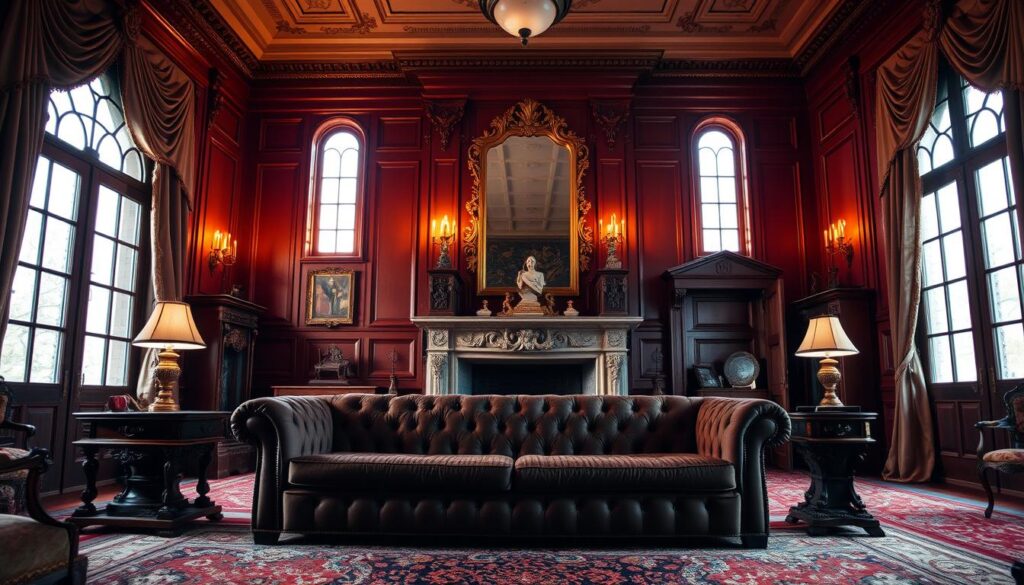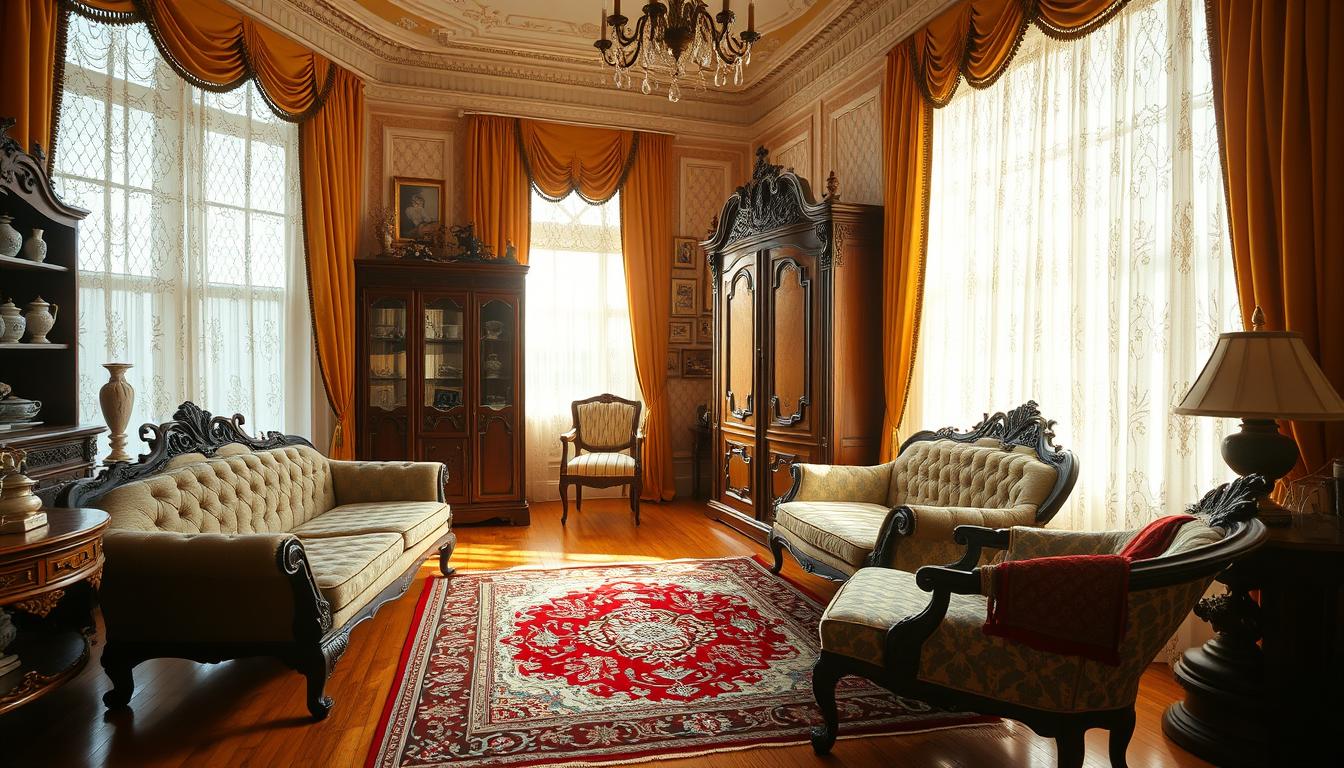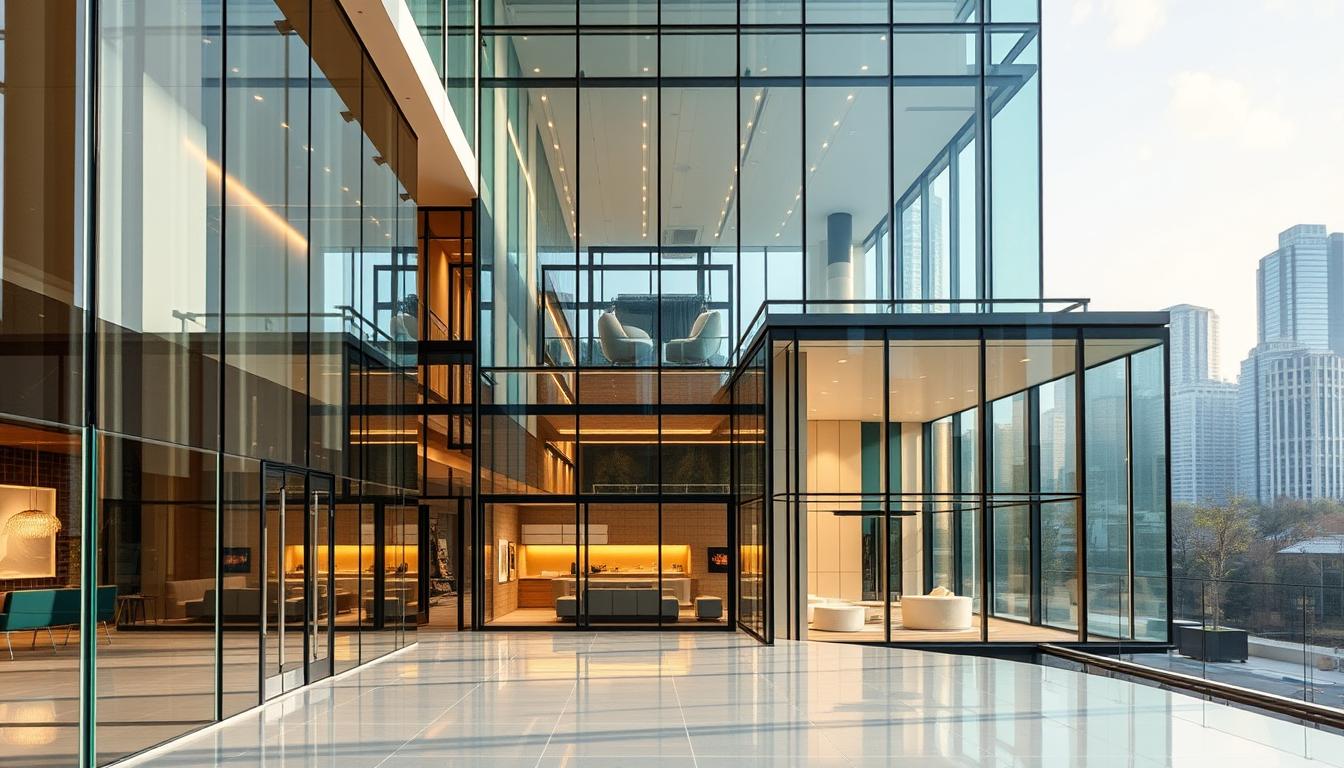The Victorian era was all about luxury and grandeur. This is seen in its detailed designs and bold colors. Now, it’s easy to add this elegance to your home with Victorian-inspired decor.
To make a Victorian-style interior, knowing the era’s design is key. We’ll share our best tips for a stunning Victorian-inspired space. We focus on keeping it true to history and paying attention to every detail.
Key Takeaways
- Understand the key characteristics of Victorian style
- Choose a bold and rich color palette
- Incorporate intricate details and patterns
- Use textures and materials that define the era
- Bring elegance into your modern space
Understanding Victorian Design Elements
Victorian interior design is a mix of intricate patterns, ornate furnishings, and rich colors. These elements make a Victorian home unique. They add depth and beauty to any space.
Key Characteristics of Victorian Style
Victorian style is all about grandeur and opulence. It features intricately carved furniture and complex patterns. Interior design historian Jane Smith says, “The Victorian era was a time of great change and innovation. This is seen in its eclectic mix of influences.”
The style combines elements from different historical periods. This creates a unique blend of Gothic, Rococo, and other styles.
Popular Color Palettes
Victorian interiors are known for their bold colors. Deep reds, emerald greens, and rich berry tones were favorites. These colors were often paired with neutral backgrounds for balance.
These color schemes added warmth and depth to rooms. They also showed the Victorian love for drama and opulence.
Some favorite color combinations include:
- Emerald green and gold
- Deep red and cream
- Navy blue and rich wood tones
Textures and Materials
The Victorian era loved varied textures and materials. Velvet and lace added luxury, while carved wood brought warmth. These elements made Victorian interiors inviting and visually interesting.
Common materials from the Victorian era include:
| Material | Characteristics | Common Uses |
|---|---|---|
| Velvet | Luxurious, soft | Upholstery, drapes |
| Carved Wood | Intricately detailed, warm | Furniture, paneling |
| Lace | Delicate, intricate | Curtains, tablecloths |
Furniture Selection for a Victorian Home
Choosing the right furniture is key to a Victorian-inspired home. It should feel elegant and sophisticated. The wrong pieces can ruin the look, while the right ones can make it feel like the Victorian era.
Understanding Victorian furniture is crucial for a renovation. This style is known for its detailed carvings, rich fabrics, and ornate details. These features show the era’s love for grandeur and luxury.
Essential Furniture Pieces
To get a true Victorian look, focus on these key pieces:
- Intricately Carved Sofas and Armchairs: Look for detailed carvings, tufted upholstery, and rich fabric patterns.
- Ornate Wooden Beds: Victorian beds have elaborate headboards and footboards with carved motifs and luxurious finishes.
- Marble-Topped Tables: Marble-topped tables were a Victorian decor staple, adding elegance to any room.
- Velvet-Draped Chaises: Velvet-draped chaise lounges were popular in Victorian salons for an opulent look.
Style Matching and Coordination
After picking your furniture, make sure it looks good together. Style matching and coordination are key for a cohesive look. Here are some tips:
- Unify with a Common Color Scheme: Pick a Victorian-era palette like rich reds, deep greens, and creamy whites. Stick to it for continuity.
- Balance Ornate Pieces with Simpler Ones: Mix intricate or ornate furniture with simpler pieces to avoid overwhelming the space.
- Consider the Scale: Make sure furniture fits the room and other pieces. Avoid oversized or too-small items that disrupt balance.
By choosing and coordinating your furniture well, you can create a Victorian home that’s both historically respectful and inviting. Whether you’re doing a full renovation or just adding some Victorian charm, the right furniture makes all the difference.
Choosing the Right Color Schemes
Choosing the right colors is key to capturing the essence of Victorian interior design. The Victorian era was known for its opulence and grandeur. It saw the rise of complex and rich color palettes that still inspire antique home decor lovers today.
Color in the Victorian period was more than just aesthetics. It was a way to show social status and personal taste. Classic color combinations were often inspired by nature and used in homes through various design elements.
Classic Color Combinations
Victorian interiors often mixed deep, rich colors like emerald greens, navy blues, and rich reds. These were balanced with neutral tones. This mix was a hallmark of the era’s love for drama and opulence.
- Deep reds and burgundies paired with gold accents
- Navy blues and emerald greens for a dramatic effect
- Soft pastels for a more subtle, elegant look
How to Use Accent Colors
Accent colors were crucial in Victorian design, adding depth and interest to rooms. By choosing accent colors that match the main palette, you can create a welcoming atmosphere. This is reminiscent of traditional antique home decor.
To use accent colors well, follow the 60-30-10 rule. This means 60% of the room should be a dominant color, 30% a secondary color, and 10% an accent color. This balance creates a harmonious and appealing interior.
By applying these principles, you can bring Victorian elegance into your home. You’ll create a space that is both beautiful and historically inspired.
Importance of Historical Accuracy
Getting the Victorian home interior right is key. It’s all about the era’s charm. You need to explore the design, architecture, and decor of the Victorian era.
Our guide helps you decorate a historic home right. It keeps the original look while adding modern comforts. Learn more in our article on decorating historic home interiors.
Researching Period Details
Studying the Victorian era’s details is crucial. Look at the architecture, furniture, and decor. This makes your home feel real and authentic.
Some important things to research include:
- Architectural features like moldings and doorways
- Furniture styles, like Gothic Revival
- Decor elements, such as wallpaper and textiles
Interior design expert Oscar Wilde said,
“To live in a beautiful house is a necessity for happiness.”

Authentic Accessories and Decor
Real accessories and decor are essential for the Victorian look. Look for antique furniture, vintage textiles, and old lighting. Make sure they’re real to match the era’s style.
| Item | Period Characteristic | Authenticity Tip |
|---|---|---|
| Antique Furniture | Gothic Revival or Rococo styles | Look for signs of aging and craftsmanship |
| Vintage Textiles | Rich patterns and luxurious fabrics | Check for original labels or provenance |
| Lighting Fixtures | Ornate metalwork and crystal details | Verify the materials and craftsmanship |
Focus on historical accuracy and use real accessories. This way, your Victorian home interior will be captivating and true to the era.
Floor Plans and Spatial Considerations
Designing a Victorian home is a mix of keeping its old charm and making it modern. It’s important to think about the floor plan and how it affects living. This helps make the home feel right for today’s needs.
Choosing between an open or closed layout is a big decision. Victorian homes often have separate rooms, which can make them feel broken up.
Open vs. Closed Layouts
An open layout can make a home feel bigger and more connected. But, it’s key to keep the home’s original look in mind.
Keeping a closed layout helps keep the home’s history alive. It’s perfect for those who want to keep the Victorian feel.
| Layout Type | Advantages | Disadvantages |
|---|---|---|
| Open Layout | Creates a sense of spaciousness, modern feel | May lose historical character |
| Closed Layout | Preserves historical integrity, separate rooms | Can feel fragmented, less modern |
Maximizing Space in Victorian Homes
To make Victorian homes bigger, you need to be creative. Using victorian style furniture that does double duty, like storage ottomans or Murphy beds, is a smart move.
Smart storage is also key. Adding hidden spots for things, shelves, and cabinets keeps the home tidy and looking good.
In victorian interior design, it’s all about finding a balance. By picking the right furniture and using clever storage, you can make a home that looks great and works well.
Incorporating Vintage Decor
To truly capture the essence of a Victorian home, incorporating vintage decor is essential. Vintage elements not only add character but also bring a sense of history and authenticity to your living space.
Authentic Antiques
Finding authentic antiques can be a thrilling experience. Thrift stores, estate sales, and antique shops are treasure troves for unique pieces that can elevate your Victorian home’s interior. When searching for antiques, it’s crucial to know how to authenticate them. Look for signs of aging, craftsmanship, and historical markers that can verify the piece’s era.
Reproductions vs. Originals
The debate between choosing reproductions or original antiques depends on several factors, including budget, personal preference, and the level of authenticity desired. Original antiques offer a genuine historical feel, while reproductions can be more affordable and still capture the Victorian aesthetic. Ultimately, a balanced mix of both can create a rich and layered decor.
When incorporating vintage decor, it’s essential to strike a balance between old and new. By combining antique pieces with modern elements, you can create a unique and inviting atmosphere in your Victorian home.
Lighting Choices for Victorian Interiors
In Victorian homes, lighting was more than just a need. It was a way to show off style. You’ll find everything from gas lamps to fancy chandeliers.
Types of Lighting Fixtures
Victorian homes had unique lighting that added to their charm. Here are some favorites:
- Gas lamps: These were common, even before electricity was widespread.
- Candelabras: They brought elegance and served as both lights and decorations.
- Ornate chandeliers: These were often the room’s centerpiece, with detailed designs and materials like crystal.
Placement and Ambiance
Where you put your lights is key to the right feel in a Victorian home. Here’s how to do it:
- Layered lighting: Mix different lights for a warm, welcoming vibe.
- Highlight focal points: Use lights to spotlight special features or decorations.
- Adjustable lighting: Choose fixtures that let you change brightness and direction for any event.
By picking and placing lights wisely, you can make your Victorian home cozy and true to its past.
Window Treatments in Victorian Homes
Victorian-era window treatments were known for their grandeur and detailed designs. They showed the period’s love for luxury. In Victorian homes, windows were more than just for light; they were design highlights.

Styles and Materials
The Victorian era had many window treatment styles, from heavy drapes to carved wooden shutters. Velvet curtains were a favorite, often lined with silk or cotton for extra luxury. Rich fabrics and ornate patterns were key in classic home decor back then.
High-quality materials were used, like mahogany and oak for shutters, and luxurious fabrics for curtains. The choice of material and style depended on the room’s purpose and the desired mood.
Layering Techniques for Elegance
Layering was a crucial technique in Victorian window treatments for elegance and depth. It involved combining curtains, drapes, and shutters. Layering enhanced the look and helped control light and keep warmth in.
To enhance Victorian home decor, tiebacks, valances, and tassels were used. These added to the windows’ ornate look and served practical purposes.
Adding Modern Touches
Updating a Victorian home with modern elements needs careful thought. We talked about this in our tips on revamping Victorian homes. It’s key to keep the original design while adding new features.
Balancing Old and New
When mixing modern with traditional Victorian design, finding a balance is crucial. Choose modern pieces that match the home’s look. For example, modern lighting can brighten a room without losing its Victorian charm.
Innovative Technologies in Victorian Design
Adding new tech can make Victorian homes more functional and green. Smart home systems, for instance, can be added without changing the home’s look.
| Design Element | Traditional Victorian | Modern Counterpart |
|---|---|---|
| Lighting | Candelabras, Gaslights | LED Lighting, Smart Bulbs |
| Flooring | Hardwood, Ornate Carpets | Engineered Hardwood, Luxury Vinyl Tiles |
| Window Treatments | Heavy Drapery, Velvet Curtains | Motorized Blinds, Solar Shades |
By adding modern touches and new tech, homeowners can have it all. They get the charm of a Victorian home and the benefits of modern living.
Maintaining a Cohesive Design Theme
To make a Victorian home interior truly stunning, keeping a unified design theme is key. A thoughtful approach is needed for a Victorian home renovation. This ensures each room complements the others beautifully.
Design Continuity
Design flow is essential in a Victorian home. We keep it by sticking to a consistent color palette, texture, and pattern. This creates a sense of harmony and makes the space feel larger and more elegant.
Visual Harmony
To enhance your Victorian home renovation, we mix textures, patterns, and colors. This balance creates a welcoming and visually appealing atmosphere. It highlights the beauty of the Victorian era.
By sticking to these principles, we craft a Victorian home interior that’s both authentic and beautiful. It’s a perfect mix of old and new.


